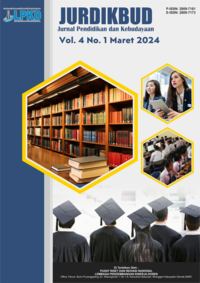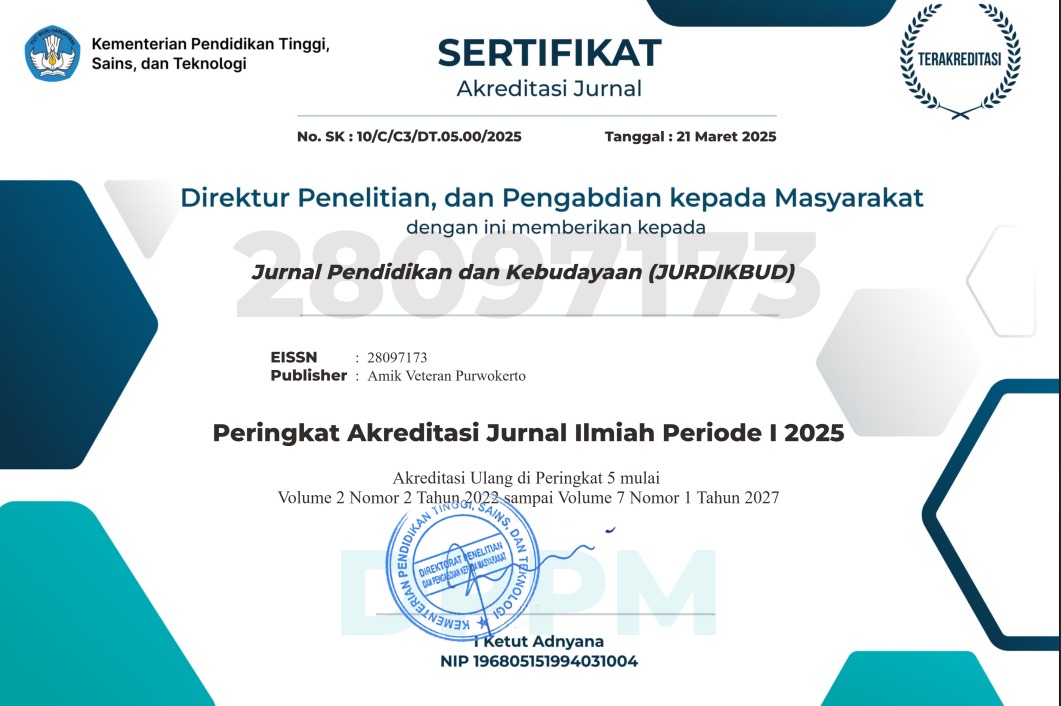Badik Makassar: Kajian Visual dalam Perspektif Estetika Clive Bell
DOI:
https://doi.org/10.55606/jurdikbud.v5i2.5987Keywords:
Badik Makassar, Aesthetics, Art, Clive BellAbstract
This study aims to examine the visual form of the Makassar Badik through the perspective of Clive Bell's aesthetic theory (significant form). Badik, as a cultural heritage of South Sulawesi, not only functions as a means of defense but also as a symbol of identity, honor, and social values of the Makassar community. This study uses a qualitative-descriptive method, with data collection techniques in the form of interviews, observations, and document studies. The data validation technique used is triangulation. The data is then analyzed qualitatively by grouping the findings into themes. The results of this study indicate that every part of the Badik, starting from the pangulu, the blade, to the banoang, is able to create a deep aesthetic and emotional experience for the community and its observers. This study confirms that the Makassar Badik not only functions as a weapon, but also as a work of art that is full of cultural, spiritual, and social values.
References
Abdullah, H. (1985). Manusia Bugis Makassar: Suatu tinjauan historis terhadap pola tingkah laku dan pandangan hidup manusia Bugis Makassar. Inti Idayu Press.
Badewi, M. H. (2019). Nilai Siri’ dan Pesse dalam kebudayaan Bugis-Makassar, dan relevansinya terhadap penguatan nilai kebangsaan. Jurnal Sosiologi Walisongo, 3(1), 79–96. https://doi.org/10.21580/jsw.2019.3.1.3291
Bell, C. (1914). Art. Frederick A. Stokes.
Ewa, T. (2017). Mengenal senjata pusaka Sulawesi. CV. Social Politic Genius.
Heryani, W., Diar, D., & Mualif, Z. (2021). Pluralisme hukum terhadap penggunaan badik oleh suku Bugis Makassar. Hasanuddin Justice and Society, 1, 44–59.
Hussey, M. (2018). Case study: Clive Bell and the legacies of significant form. Dalam The handbook to the Bloomsbury Group (hlm. xxx–xxx). Bloomsbury Publishing Plc.
Lanta, L., Syahrir, N., & Cahyadi, D. (2019). Laca’ badik Makassar: Suatu studi identifikasi pakem (laca’) bentuk-bentuk badik Makassar. TANRA: Jurnal Desain Komunikasi Visual Fakultas Seni dan Desain Universitas Negeri Makassar, 6(3). https://doi.org/10.26858/tanra.v6i3.13013
Mardiana, D., & Fauzi, I. (2022, Mei). Makna kultural benda-benda bersejarah peninggalan Kesultanan Kutaringin: Sebuah pendekatan semantik pedagogis. Dalam Prosiding Seminar Nasional Pendidikan, Bahasa, Sastra, Seni, dan Budaya (Vol. 1, No. 1, hlm. 247–262).
Mattulada. (1974). Bugis-Makassar: Manusia dan kebudayaannya. Jurusan Antropologi FSUI.
Mattulada. (1978). Latoa: Suatu lukisan analitis terhadap antropologi politik orang Bugis. Universitas Indonesia.
McLaughlin, T. M. (1977). Clive Bell’s aesthetic: Tradition and significant form. The Journal of Aesthetics and Art Criticism, 35(4), 433–443. https://doi.org/10.2307/430609
Mualif, Z. (2020). Tinjauan antropologi hukum terhadap penggunaan badik di Kota Makassar [Disertasi doktoral, Universitas Hasanuddin].
Usop, L. S. (2020). Peran kearifan lokal masyarakat Dayak Ngaju untuk melestarikan pahewan (hutan suci) di Kalimantan Tengah. ENGGANG: Jurnal Pendidikan, Bahasa, Sastra, Seni, dan Budaya, 1(1), 89–95.
Yamin, M. W. (2017). Tinjauan hukum terhadap penggunaan badik di Kota Makassar. Institut Sosial dan Bisnis Andi Sapada. https://doi.org/10.31219/osf.io/fdt5e
Zeki, S. (2013). Clive Bell’s “significant form” and the neurobiology of aesthetics. Frontiers in Human Neuroscience, 7, 730. https://doi.org/10.3389/fnhum.2013.00730
Downloads
Published
How to Cite
Issue
Section
License
Copyright (c) 2025 Jurnal Pendidikan dan Kebudayaan (JURDIKBUD)

This work is licensed under a Creative Commons Attribution-ShareAlike 4.0 International License.








